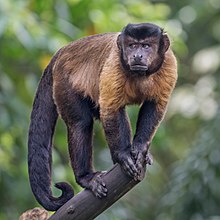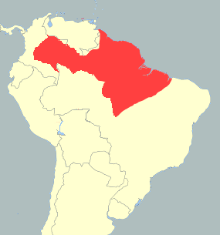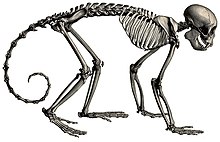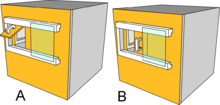| Tufted capuchin | |
|---|---|

| |
| At River Wonders, Singapore | |
| Conservation status | |
 Least Concern (IUCN 3.1) | |
| Scientific classification | |
| Domain: | Eukaryota |
| Kingdom: | Animalia |
| Phylum: | Chordata |
| Class: | Mammalia |
| Order: | Primates |
| Suborder: | Haplorhini |
| Infraorder: | Simiiformes |
| Family: | Cebidae |
| Genus: | Sapajus |
| Species: | S. apella |
| Binomial name | |
| Sapajus apella (Linnaeus, 1758) | |
| Subspecies | |
|
Sapajus apella macrocephalus Sapajus apella apella | |

| |
| Geographic range following taxonomy used by IUCN | |

| |
| Range of subspecies macrocephalus | |
| Synonyms | |
| |
The tufted capuchin (Sapajus apella), also known as brown capuchin, black-capped capuchin, or pin monkey, is a New World primate from South America and the Caribbean islands of Trinidad and Margarita. As traditionally defined, it is one of the most widespread primates in the Neotropics, but it has recently been recommended considering the black-striped, black and golden-bellied capuchins as separate species in a new genus, thereby effectively limiting the tufted capuchin to the Amazon basin and nearby regions. However, the large-headed capuchin (S. a. macrocephalus), previously defined as a distinct species, has been reclassified as a subspecies of the tufted capuchin, expanding its range east to Peru and Ecuador and south to Bolivia.
The tufted capuchin is an omnivorous animal, mostly feeding on fruits and invertebrates, although it sometimes feeds on small vertebrates (e.g. lizards and bird chicks) and other plant parts. It can be found in many different kinds of environment, including moist tropical and subtropical forest, dry forest, and disturbed or secondary forest.
Like other capuchins, it is a social animal, forming groups of 8 to 15 individuals that are led by an alpha or dominant male.
Taxonomy and phylogeny
At one point all tufted capuchins were classified as Cebus apella. Under such taxonomy, the range of C. apella would extend throughout much of South America from Colombia to northern Argentina. Although she did not describe specific or subspecific nomenclature, Torres de Assumpção (1983; 1988) described differences between tufted capuchins from five distinct geographic regions of Brazil and high phenotypic variation of individuals in a sixth area that had a greater selection pressure. In 2001, Silva Júnior proposed that the robust capuchins such (formerly the C. apella group) be placed in a separate genus, Sapajus, from the gracile capuchins (formerly the C. capucinus group) which retain the genus Cebus. This was supported by Jessica Lynch Alfaro et al. in 2011. Groves (2005) recognized six subspecies: Cebus apella apella, C. a. fatuellus, C. a. macrocephalus, C. a. margaritae, C. a. peruanus, C. a. tocantinus. The IUCN follows Silva (2001) and recognise the species as monotypic, though the subspecies status of S. a. margaritae is unclear.
Physical characteristics

The tufted capuchin is more powerfully built than the other capuchins, with rougher fur and a long, thick tail. It has a bundle of long, hardened hair on the forehead that can be raised as a sort of "wig". The fur is brownish gray, with the belly being somewhat lighter-colored than the rest of the body. The hands and feet are black. The tail is prehensile: strong and can be used for grasping, as an extra limb.
The tufted capuchin has a head-body length of 32 to 57 centimetres (13 to 22 in), a tail length of 38 to 56 centimetres (15 to 22 in), and a weight of 1.9 to 4.8 kilograms (4.2 to 10.6 lb), with the males generally being larger and heavier than the females.
Behaviour and ecology
The tufted capuchin is a diurnal, arboreal primate species, but it often forages on the ground to search for food or to walk longer distances between trees that are too far apart to jump.
The tufted capuchin lives in groups of two to twenty or more animals. A single group usually contains at least one adult male, but mixed groups with multiple males do also occur. In that case, one of the males is dominant. He accepts only a few monkeys in his direct surroundings, mainly younger animals and a few females. The dominant male and the group members that are close to him have the privilege to eat first in case of food scarcity, while subordinate monkeys have to wait until they are ready.
After a gestation period of 180 days, one young is born, or incidentally a twin. This young, which weighs only 200 to 250 grams (7.1 to 8.8 oz), is carried on the back of its mother. The mother feeds her child for 9 months, but the young are sexually immature until its seventh year, which is quite late for a primate of its size.
Important natural enemies of the capuchin are large birds of prey. They are so afraid of those birds that they even become alarmed when a harmless bird flies over.
Diet
A recently discovered characteristic of one population of this species is that it uses stones as a tool to open hard nuts. First it chooses ripe nuts from a nut palm. It uses its teeth to strip off the nut's fibrous husk. Then it leaves the nut to dry for about a week. When the nut is dry, the monkey lays the nut on a large, flat rock or fallen tree, hammering the nut with a suitable stone until the nut cracks. The hammerstones are often large enough to require lifting with both hands. The anvil rock is often pockmarked with hollows as a result of repeated use.
Besides nuts, the capuchin also eats fruit, leaves, seeds, pith, insects and larvae, eggs and young birds, frogs, lizards, other reptiles, rodents, mouse opossums, and even bats. They are also known to chase cats.
The tufted capuchin looks for its food in groups. As soon as one of the group members has found something edible, he or she may make a large whistling sound, dependent upon the proximity of other individuals and abundance of the food resource so that the other monkeys know that there is something to eat. The composition of the group is very well organized and is determined by rank in the hierarchy. The dominant male often resides somewhere in the middle of the group just behind the front line, so that it is safer when a predator attacks. The vanguard is composed of higher-ranked females who are tolerated by the dominant male. They have the privilege to reach the food first, but they are also the most vulnerable when a predator attacks. It is a host of the acanthocephalan intestinal parasite Pachysentis rugosus.
Tool use and manufacture
See also: Primate archaeologyThe tufted capuchin has been observed using containers to hold water, using sticks (to dig nuts, to dip for syrup, to catch ants, to reach food), using sponges to absorb juice, using stones as hammer and chisel to penetrate a barrier and using stones as hammer and anvil to crack nuts. While some of these tasks are relatively simple by cognitive standards (e.g. using a stick to catch ants), others, like cracking nuts with hammer and anvil are only exceeded in complexity by chimpanzees.
The potential for tool use in animals like the tufted capuchin depends on a number of conditions that would increase its likelihood of appearing in a given species. Van Schaik proposed that the occurrence of tool use would be likely in foraging species if three factors were present: manual dexterity, intelligence, and social tolerance. As it applies to manual dexterity, capuchins are capable of a limited precision grip (the ability to delicately pinch and manipulate objects with the thumb and fingertips), which is not found in any other New World monkeys and only found in limited amounts in apes. C. apella has an encephalization ratio greater than the hominids (except humans) and a neocortex ratio that is almost as large as the apes; both of these rough indicators suggest high intelligence. Finally, the tufted capuchin forms social groups typical of a complex and tolerant society.
The tufted capuchin has been observed manufacturing tools both in captivity and in the wild. In captivity, it has been reported as making probing sticks to reach normally inaccessible containers with syrup. It is also capable of understanding the concept of "sponging" and using paper towels, monkey biscuits, sticks, leaves and straw to sop up juice and then suck on the sponge to consume the juice. Research in the wild has shown that capuchin tool use is every bit as extensive as in captivity with capuchins being observed using stones to dig holes to get at tubers, an activity previously only seen in humans. The practice of using stones to crack nuts has arisen spontaneously in many locations such as in the Caatinga Dry Forest and Serra da Capivara National Park, all in Brazil and hundreds of miles apart. It has been observed cracking various nuts and fruits such as palm nuts (Attalea and Astrocaryum spp.) and jatobá fruits (Hymenaea courbaril). The tufted capuchin has even been observed using stones to dislodge other stones that would later be used as hammers or shovels, an example of a more complex tool using behavior known as second-order tool use previously only found in chimpanzees. Curiously, not all tufted capuchins engage in tool use. Moura and Lee (2004) suggest lack of other food sources as the key factor. Ottoni and Mannu (2001), Fragaszy et al. (2004) and Visalberghi et al. (2005) have proposed this is likely more a factor of a monkey's terrestrial habit: the more time a monkey spends on the ground, the more likely it is to profit from (and thus engage in) tool use.
In captivity, the tufted capuchin has been seen to manufacture stone tools that produced simple flakes and cores. Some of the capuchins even used these sharpened stones to cut (in a back-and-forth motion) barriers in order to reach food. The importance of this behavior is that it serves as evidence of mechanical proclivity to modify stones by using behaviors already in the monkeys' repertoires, and this behavior is seen as a precursor to stone-knapping. This early and limited tool use behavior has been hypothesized as similar to pre-Homo habilis and that artifacts of that time would probably resemble those of capuchins.
S. apella tool manufacture and use has been analyzed for potential clues to social learning and problem solving ability, as tool manufacture and use can often shed light on such complex cognitive abilities. Social learning, or the ability to learn from other individuals, is a controversial topic in most nonhuman species like S. apella because of the relative difficulty of determining whether a behavior was learned from imitation or a much simpler form of social learning. One way of closing the gap between concurrent tool related behaviors and their likelihood of arising from imitation is by narrowing down events that would make social learning more probable such as a preference for observing experienced tool users. In this regard, Ottoni and his team found that young capuchins tended to observe the best tool users when cracking nuts.

Another way of isolating imitation from other simpler behaviors is to present the capuchins with a box that has food but has two different ways of opening it. The important point is that neither way should be more advantageous so that the monkey can freely choose one. In one such study, when humans opened the door in front of the monkeys using one way only, the monkeys used that method, even when they discovered the alternative on their own. In another study, capuchin alphas from two separate groups were trained to open the door in a specific way, after which the monkeys were paired with subordinates who learned to open the door in the same way. When capuchins are trained in the same way and this time released into their groups, the habit is once again disseminated amongst all group members even when others discover alternative ways. Nevertheless, the subject of whether or not S. apella learns by imitation is still controversial, because of the inherent difficulty in teasing out unambiguous evidence of a complex cognitive process such as imitation.
Problem solving
Tool use and manufacture can also shed light on the many aspects of the tufted capuchin's cognitive abilities by determining how it solves some problems. Some non-primates manufacture and use objects as tools. Crows are known to make hook-tools for catching insects, but such activities lack the behavioral plasticity of tool use as evidenced in tufted capuchins who found new ways to use tools that other species could not. But this plasticity in tool use, while suggesting greater complexity and cognitive ability, does not suggest that the monkeys understand cause and effect. It instead implies they are only able to learn from successful efforts but not from failures, nor are they able to refine and improve much. Its ability to repeat successes, coupled with its complex repertoire of behavioral events helps to explain the tufted capuchin's extensive repertoire of innovative behaviors besides tool use.
Distribution and habitat
This species lives in the northern Amazon rainforest of the Guyanas, Venezuela and Brazil and to the west of the Rio Negro, as far north as the Orinoco in Venezuela. It is also found in eastern Colombia, Ecuador, Bolivia, Peru, including the upper Andean Magdalena valley in Colombia. An introduced breeding population is well established in the northwestern peninsula of the island of Trinidad in the Republic of Trinidad and Tobago. The subspecies/population on Margarita Island in Venezuela, S. a. margaritae, is considered Critically Endangered by the IUCN Red List. It can be found in a large variety of forest types, mainly in tropical rainforests (up till a height of 2700 m), but also in more open forests.
The distribution overlaps with that of other species of capuchins, such as the white-fronted capuchin (Cebus albifrons).
References
- ^ Groves, C. P. (2005). Wilson, D. E.; Reeder, D. M. (eds.). Mammal Species of the World: A Taxonomic and Geographic Reference (3rd ed.). Baltimore: Johns Hopkins University Press. p. 137. ISBN 0-801-88221-4. OCLC 62265494.
- ^ Boubli, J.P., Stevenson, P.R., Palacios, E., de la Torre, S., Ravetta, A.L., Messias, M.R., Carvalho, A.S. & Mittermeier, R.A. 2021. Sapajus apella (amended version of 2020 assessment). The IUCN Red List of Threatened Species 2021: e.T172351505A192594550. Sapajus apella - Black-capped Capuchin. Downloaded on 26 August 2021.
- Lima, Marcela G. M.; Silva-Júnior, José de Sousa e; Černý, David; Buckner, Janet C.; Aleixo, Alexandre; Chang, Jonathan; Zheng, Jimmy; Alfaro, Michael E.; Martins, Amely; Di Fiore, Anthony; Boubli, Jean P. (1 July 2018). "A phylogenomic perspective on the robust capuchin monkey (Sapajus) radiation: First evidence for extensive population admixture across South America". Molecular Phylogenetics and Evolution. 124: 137–150. doi:10.1016/j.ympev.2018.02.023. ISSN 1055-7903. PMID 29545109. S2CID 4589398.
- Hershkovitz, P. (1949). "Mammals of northern Colombia. Preliminary report No. 4: Monkeys (primates), with taxonomic revisions of some forms". Proceedings of the United States National Museum. 98 (3232): 1–323. doi:10.5479/si.00963801.98-3232.323.
- Hershkovitz, P. (1955). "Notes on American monkeys of the genus Cebus". Journal of Mammalogy. 36 (3): 449–452. doi:10.2307/1375688. JSTOR 1375688.
- Torres de Assumpcao, C. (1983). An ecological study of the primates of southeastern Brazil, with a reappraisal of Cebus apella races (PhD). University of Edinburgh.
- Torres de Assumpcao, C. (1988). "Resultados preliminares de reavaliacao das racas do macaco-prego Cebus apella (Primates: Cebidae)". Revista Nordestina de Biologia. 6: 15–28.
- Silva, J.S. Jr. (2001). Especiacao nos macacos-pregos e caiararas, género Cebus Erxleben, 1777 (Primates, Cebidae) (PhD). Universidade Federal do Rio de Janeiro.
- Lynch Alfaro, J.W.; et al. (2011). "Explosive Pleistocene range expansion leads to widespread Amazonian sympatry between robust and gracile capuchin monkeys" (PDF). Journal of Biogeography. 39 (2): 272–288. doi:10.1111/j.1365-2699.2011.02609.x. S2CID 13791283. Archived from the original (PDF) on 26 February 2015.
- Lynch Alfaro, J.W.; Silva, J.S. Jr.; Rylands, A.B. (2012). "How different are robust and gracile capuchin monkeys? An argument for the use of Sapajus and Cebus". American Journal of Primatology. 74 (4): 1–14. doi:10.1002/ajp.22007. PMID 22328205. S2CID 18840598.
- Madden, M.; Fragaszy, D.M.; Izar, P.; Hinley, A.J.; Ottoni, E.B.; Visalberghi, E. (2007). "Modelling the monkey habitat in Brazil" (PDF). Geospatial Today (5): 26–35. Archived from the original (PDF) on 17 July 2011.
- Discovery "Life" series, "Challenges of Life" episode, David Attenborough
- Waga, I.C.; Dacier, A.K.; Pinha, P.S.; Tavares, M.C.H. (2005). "Spontaneous tool use by wild capuchin monkeys (Cebus libidinosus) in the Cerrado". Folia Primatologica. 77 (5): 337–344. doi:10.1159/000093698. PMID 16912501. S2CID 19546828.
- "The Online Guide to the Animals of Trinidad and Tobago" (PDF). Retrieved 17 August 2023.
- ^ "Cebus apella (Brown capuchin)". Animal Diversity Web.
- Di Bitetti, M.S. (2005). "Food-associated calls and audience effects in tufted capuchin monkeys, Cebus apella nigritus". Animal Behaviour. 69 (4): 911–919. doi:10.1016/j.anbehav.2004.05.021. hdl:11336/45480. S2CID 53178841.
- Corrêa, Pilar; Bueno, Cecília; Soares, Rita; Vieira, Fabiano M.; Muniz-Pereira, Luís C. (2016). "Checklist of helminth parasites of wild primates from Brazil". Revista Mexicana de Biodiversidad. 87 (3): 908–918. doi:10.1016/j.rmb.2016.03.008.
- ^ Westergaard, G.C. (1995). "The subsistence technology of capuchins". International Journal of Primatology. 16 (1): 899–906. doi:10.1007/BF02736075. S2CID 7703148.
- ^ Ottoni, E.; Dogo de Resende, B.; Izar, P. (2005). "Watching the best nutcrackers: what capuchin monkeys (Cebus apella) know about others' tool-using skills". Animal Cognition. 8 (4): 215–219. doi:10.1007/s10071-004-0245-8. PMID 15719240. S2CID 51862020.
- Westergaard, Gregory Charles (1999). "Structural analysis of tool-use by tufted capuchins (Cebus apella) and chimpanzees (Pan troglodytes)". Animal Cognition. 2 (3): 141–145. doi:10.1007/s100710050034. S2CID 40181377.
- van Schaik, C.; D.R; M.M. (1999). "The conditions for tool use in primates: implications for the evolution of material culture" (PDF). Journal of Human Evolution. 36 (6): 719–741. doi:10.1006/jhev.1999.0304. PMID 10330335.
- ^ Cummins-Sebree, S.E.; Fragaszy, D.M. (2005). Capuchins as stone-knappers?: an evaluation of the evidence. Stone knapping: the necessary conditions for a uniquely hominin behaviour. Cambridge, England: McDonald Institute for Archaeological Research. p. 171. ISBN 978-1-902937-34-2.
- Costello, M.; Fragaszy, D. (1988). "Prehension in Cebus and Saimiri: Grip type and hand preference". American Journal of Primatology. 15 (3): 235–245. doi:10.1002/ajp.1350150306. PMID 31968893. S2CID 86556774.
- Rilling, J.; Insel, T.R. (August 1999). "The primate neocortex in comparative perspective using magnetic resonance imaging". Journal of Human Evolution. 37 (2): 191–223. doi:10.1006/jhev.1999.0313. PMID 10444351.
- Dunbar, R. (1998). "The social brain hypothesis". Evolutionary Anthropology: Issues, News, and Reviews. 6 (5): 178–190. doi:10.1002/(SICI)1520-6505(1998)6:5<178::AID-EVAN5>3.0.CO;2-8. S2CID 9555943.
- Izar, P. (2004). "Female social relationships of Cebus apella nigritus in a southeastern Atlantic forest". Behaviour. 141 (1): 71–99. doi:10.1163/156853904772746619.
- Visalberghi, E.; Fragaszy, D. (1995). "The behaviour of capuchin monkeys, Cebus apella, with novel food: the role of social context". Animal Behaviour. 49 (4): 1089–1095. doi:10.1006/anbe.1995.0137. S2CID 53191563.
- ^ Westergaard, G.C.; Fragaszy, D. (1987). "The manufacture and use of tools by capuchin monkeys (Cebus apella)". Journal of Comparative Psychology. 101 (2): 159–168. doi:10.1037/0735-7036.101.2.159.
- ^ Moura, A.C.; Lee, PC (2004). "Capuchin stone tool use in Caatinga dry forest". Science. 306 (5703): 1909. doi:10.1126/science.1102558. PMID 15591195. S2CID 36793833.
- ^ Mannu, M.; Ottoni, E. (2009). "The enhanced tool-kit of two groups of wild bearded capuchin monkeys in the Caatinga: tool making, associative use, and secondary tools". American Journal of Primatology. 71 (3): 242–251. doi:10.1002/ajp.20642. PMID 19051323. S2CID 3479020.
- ^ Fragaszy, D.; Izar, P.; Visalberghi, E.; Ottoni, E.B.; de Oliveira, M.G. (2004). "Wild capuchin monkeys (Cebus libidinosus) use anvils and stone pounding tools". American Journal of Primatology. 64 (4): 359–366. doi:10.1002/ajp.20085. PMID 15580579. S2CID 16222308.
- Moura, A.C. de A.; Lee, P.C. (2004). "Capuchin stone tool use in Caatinga dry forest". Science. 306 (5703): 1909. doi:10.1126/science.1102558. PMID 15591195. S2CID 36793833.
- Ottoni, E.B.; Mannu, M. (2001). "Semifree-ranging tufted capuchins (Cebus apella) spontaneously use tools to crack open nuts". International Journal of Primatology. 22 (3): 347–358. doi:10.1023/A:1010747426841. S2CID 29768277.
- Visalberghi, E.; et al. (2005). "Terrestriality and tool use". Science. 308 (5724): 951–952. doi:10.1126/science.308.5724.951c. PMID 15890860. S2CID 29819009.
- ^ Westergaard, G.C.; Suomi, S.J. (December 1995). "The stone tools of capuchins (Cebus apella)". International Journal of Primatology. 16 (6): 1017–1024. doi:10.1007/BF02696114. S2CID 33211414.
- Visalberghi, E.; Trinca, L. (1989). "Tool use in capuchin monkeys: Distinguishing between performing and understanding". Primates. 30 (4): 511–521. doi:10.1007/BF02380877. S2CID 19285572.
- Fragaszy, D.; E. Visalberghi (1989). "Social influences on the acquisition of tool-using behaviors in tufted capuchin monkeys (Cebus apella)". Journal of Comparative Psychology. 103 (2): 159–170. doi:10.1037/0735-7036.103.2.159. PMID 2736909.
- ^ Custance, D.; Whiten, A.; Fredman, T. (1999). "Social learning of an artificial fruit task in capuchin monkeys (Cebus apella)". Journal of Comparative Psychology. 113 (1): 13–22. doi:10.1037/0735-7036.113.1.13.
- Dindo, M.; Thierry first 2=B.; Whiten, A. (2008). "Social diffusion of novel foraging methods in brown capuchin monkeys (Cebus apella)". Proceedings of the Royal Society B. 275 (1631): 187–93. doi:10.1098/rspb.2007.1318. PMC 2596191. PMID 17971322.
{{cite journal}}: CS1 maint: numeric names: authors list (link) - Dindo, M.; Whiten, A.; De Waal, F. (2009). Ferrari, P.F. (ed.). "In-group conformity sustains different foraging traditions in capuchin monkeys (Cebus apella)". PLOS ONE. 4 (11): e7858. Bibcode:2009PLoSO...4.7858D. doi:10.1371/journal.pone.0007858. PMC 2773420. PMID 19924242.
- Visalberghi, E.; Fragaszy, D.M. (2002). "'Do monkeys ape?' - Ten years after.". In Nehaniv, C.L.; Dautenhahn, K. (eds.). Imitation in animals and artifacts. MIT Press. p. 494. ISBN 978-0-262-04203-1.
- Hunt, G. (1996). "Manufacture and use of hook-tools by New Caledonian crows". Nature. 379 (6562): 249–251. Bibcode:1996Natur.379..249H. doi:10.1038/379249a0. S2CID 4352835.
- Cummins-Sebree, S.E.; Fragaszy, D. (2005). "Choosing and using tools: Capuchins (Cebus apella) use a different metric than tamarins (Saguinus oedipus)". Journal of Comparative Psychology. 119 (9): 210–219. doi:10.1037/0735-7036.119.2.210. PMID 15982164.
- ^ Visalberghi, E.; Limognelli, L. (1994). "Lack of comprehension of cause-effect relations in tool-using capuchin monkeys (Cebus apella)". Journal of Comparative Psychology. 108 (1): 511–521. doi:10.1037/0735-7036.108.1.15. PMID 8174341.
- Ceballos-Mago, N.; Lynch Alfaro, J.W. (2020). "Sapajus apella ssp. margaritae". IUCN Red List of Threatened Species. 2020: e.T4079A70611951. doi:10.2305/IUCN.UK.2020-3.RLTS.T4079A70611951.en. Retrieved 18 November 2021.
Further reading
- Notes on the taxonomy and distributions of the tufted capuchin monkeys (Cebus, Cebidae) of South America
- Janson, Charles H. (2001) "Capuchin-like Monkeys". in: MacDonald, D. (red.), The New Encyclopedia of Mammals, Oxford: Oxford University Press, p. 344–353.
- Nowak, R.M. (1999) Walker's Primates of the World. Baltimore & London: the Johns Hopkins University Press. p. 113–115.
External links
- Information about tufted capuchins at Animal Diversity Web
- Primate Info Net Cebus apella Factsheet
- Associação Mãe-da-lua Brown Capuchin (Cebus apella)
| Taxon identifiers | |
|---|---|
| Cebus apella | |
| Simia apella | |
- IUCN Red List least concern species
- Capuchin monkeys
- Mammals of the Caribbean
- Mammals of Suriname
- Primates of Brazil
- Mammals of Guyana
- Mammals of French Guiana
- Mammals of Trinidad and Tobago
- Mammals of Venezuela
- Mammals of Colombia
- Mammals of Ecuador
- Mammals of Bolivia
- Mammals of Peru
- Tool-using mammals
- Mammals described in 1758
- Taxa named by Carl Linnaeus